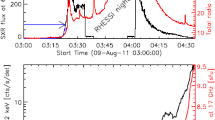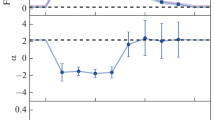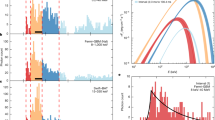Abstract
There have been several comprehensive optical and low-frequency radio surveys of flare stars1,2 but much less attention has been directed to the microwave emission from such stars. Slee and Page3 claimed to have detected one short 5-GHz flare from Proxima Centauri, and several weak, short 5-GHz bursts were reported from YZ CMi (ref. 4) and Proxima Centauri (refs 5, 6) during simultaneous X-ray, optical and microwave observations. We describe here the most convincing detection (7σ) yet made of a microwave flare during simultaneous optical and 5-GHz observations of the dMe 4.5 flare star AT Mic on 25 October 1980. This event was notable for its long duration and the good temporal correlation between the optical and microwave intensities. Unless the dimensions of the source are very much larger than those observed for solar flares, the 5-GHz source has too great a brightness temperature to be produced by the gyrosynchrotron mechanism usually invoked for solar microwave bursts. Much higher energy particles or a coherent emission mechanism must be involved in the stellar microwave flare. The observed correlation between the optical and microwave fluxes from this flare support the theories in which non-thermal electrons are responsible for both emissions.
Similar content being viewed by others
References
Spangler, S. R. & Moffett, T. J. Astrophys. J. 203, 497 (1976).
Nelson, G. J. et al. Mon. Not. R. astr. Soc. 187, 405 (1979).
Slee, O. B. & Page, A. A. Proc. IAU Colloq. 46, 150 (1979).
Kunkel, W. E. Proc. IAU Symp. 67, 15 (1975).
Karpen, J. T. et al. Astrophys. J. 216, 479 (1977).
Haisch, B. M. Astrophys. J. Lett. 225, L35 (1978).
Haisch, B. M. et al. Astrophys. J. 245, 1009 (1981).
Frost, K. J. & Dennis, B. R. Astrophys. J. 165, 655 (1971).
Crannell, C. J., Frost, K. J., Mätzler, C., Ohki, K. & Saba, J. L. Astrophys. J. 223, 620 (1978).
Stewart, R. S. & Nelson, G. J. Proc. astr. Soc. Aust. 3, 390 (1979).
Nelson, G. J. & Stewart, R. T. Proc. astr. Soc. Aust. 3, 392 (1979).
Holt, S. S. & Ramaty, R. Solar Phys. 8, 119 (1969).
Hoyng, P., Brown, J. C. & van Beek, H. F. Solar Phys. 48, 197 (1976).
Kahn, S. M. et al. Astrophys. J. Lett. 234, L107 (1979).
Heise, J. et al. Astrophys. J. Lett. 202, L73 (1975).
Mullan, D. J. Astrophys. J. 207, 289 (1976).
Gurzadyan, G. A. Flare Stars (Pergamon, Oxford, 1980).
Bruevich, V. V. et al. Proc. Crimean Astrophys. Obs. 61, 90 (1980).
Author information
Authors and Affiliations
Rights and permissions
About this article
Cite this article
Slee, O., Tuohy, I., Nelson, G. et al. Microwave emission from flare star AT Mic. Nature 292, 220–221 (1981). https://doi.org/10.1038/292220a0
Received:
Accepted:
Published:
Issue Date:
DOI: https://doi.org/10.1038/292220a0
- Springer Nature Limited





